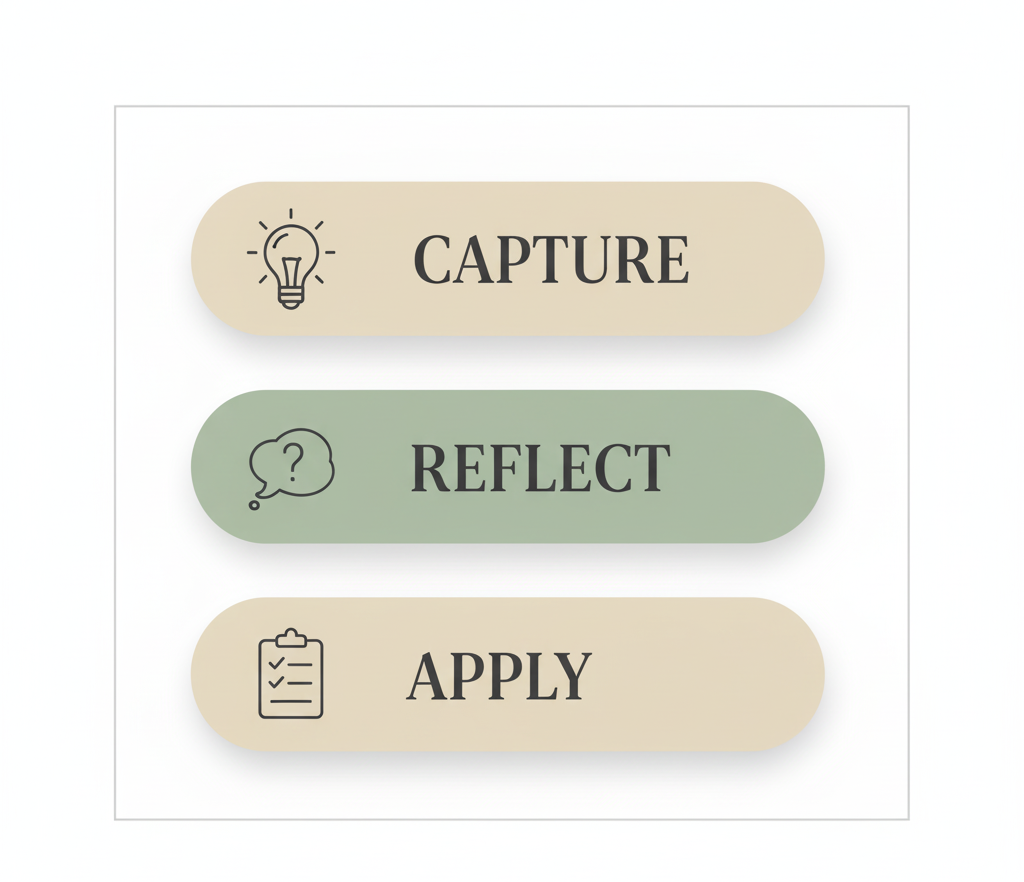When was the last time you paused long enough to really check in with yourself—without rushing to fix, optimize, or plan the next thing? For many of us, reflection happens only when something goes wrong or when we’re forced to slow down. But what if a few thoughtful questions could help you course-correct before burnout or confusion sets in?
If you’ve read my previous post, The Best Monthly Review System for You, you already know that structured reflection is a game-changer for creating more focus and flow. Think of this article as the natural next step — a short, mindful framework to help you reflect with intention, not overwhelm.
By the end, you’ll have five simple but powerful questions you can ask yourself each month (or even each week) to gain clarity, refocus your energy, and stay aligned with what actually matters.
1. What worked well this month?
We often skip right to what went wrong — but clarity starts with recognizing what’s working. This question helps you identify the habits, projects, or decisions that brought results, peace, or satisfaction.
You might realize that waking up 30 minutes earlier to journal improved your mornings, or that delegating one task freed up mental space for creative work. Write these wins down. They’re not just nice moments — they’re data points worth repeating.
Key takeaway: Before you fix, first acknowledge what’s already in flow.
If you use a note-taking tool like Notion or Reflect, create a recurring template titled Monthly Wins. I’ve found this keeps me grounded and prevents the all-too-common “I didn’t do enough” spiral.
2. What drained my energy?
Here’s where things get honest. Energy leaks don’t always come from the obvious sources — sometimes it’s subtle: meetings that drag, cluttered spaces, or saying “yes” when you meant “not this month.”
List out the moments that left you feeling scattered or tense. You might start seeing patterns: maybe it’s not the task itself but how you approach it.
Try categorizing your list into two buckets:
- Eliminate: Things you can stop or delegate.
- Adjust: Things you must do, but can simplify or reframe.
Key takeaway: Awareness is the first step to energy management.
3. What am I avoiding?

This one stings a little — but it’s often where the biggest growth hides. Ask yourself: what’s been sitting at the bottom of your list for weeks? What tasks make you sigh or scroll instead?
Avoidance isn’t always laziness; it’s often resistance rooted in fear or uncertainty. When I started noticing this pattern in my own reviews, I’d write down why I was avoiding something. Often, it came down to one of three reasons:
- I didn’t have enough clarity about the next step.
- I was afraid it wouldn’t turn out “good enough.”
- It wasn’t actually aligned with my goals anymore.
Key takeaway: Avoidance is information — it shows you what needs clarity, courage, or release.
If this resonates, try using the “Two-Minute Rule” from David Allen’s Getting Things Done: if it takes less than two minutes, do it immediately. It builds momentum fast.
4. What am I grateful for — and why?
Gratitude sounds simple, but when used intentionally, it sharpens awareness and reduces noise. This isn’t about writing a long list of things you “should” appreciate; it’s about noticing what added meaning this month.
Maybe it’s a conversation that shifted your mindset or a walk that cleared your head. The “why” part matters because it reveals what truly nourishes you — information you can use to design better months ahead.
Try writing down three things you’re grateful for, followed by “because…” You’ll start to see patterns that tell you where your energy naturally thrives.
Key takeaway: Gratitude builds perspective, and perspective fuels clarity.
5. What do I want to feel next month?
Most goal-setting focuses on outcomes, not emotions. But when you set intentions based on how you want to feel, you align your actions with what’s genuinely meaningful.
Ask yourself: do I want to feel more focused? More spacious? More connected?
Then, design your next month around habits and projects that support that feeling.
Example: If you want to feel “clear,” block time for weekly reviews or digital decluttering. If you want to feel “connected,” schedule deep work time and intentional catch-ups with people who matter.
Key takeaway: Clarity begins with feeling, not doing.
This question is also the perfect bridge back to your Monthly Review System — because systems only work when they reflect what you value.
Bringing It All Together

These five questions might seem simple, but answered consistently, they create the foundation for mindful productivity. You don’t need another planner or app (unless you love them). What you need is a practice of checking in — not to fix yourself, but to stay aligned with your priorities and energy.
Each month, set aside 20–30 minutes to sit with these questions. You can use your favorite note-taking app, a physical journal, or a digital review template like the one from the Monthly Review System.
The real goal isn’t perfection — it’s awareness.
Conclusion
Reflection isn’t a luxury; it’s maintenance for your mind. By asking these five questions regularly, you build a rhythm of awareness that keeps you from drifting off course.
If you haven’t yet created your personalized reflection structure, I recommend reading The Best Monthly Review System for You next — it’s the perfect complement to these questions and will help you create a review process that actually sticks.
Until then, take five quiet minutes this week, open a blank page, and ask yourself: What’s one question I’ve been avoiding lately? The answer might surprise you.





